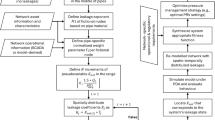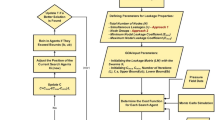Abstract
Although the quantification of lost water, due to leakages in pressure management areas (PMAs) is a crucial task for all water agencies’ financial viability, currently there is no rigorous approach for their parametric modeling including the effect of inlet/operating pressures. In this work we develop a probabilistic model for minimum night flow (MNF) estimation in water distribution networks that: (1) parametrizes the MNF as a function of the network’s specific characteristics (topography, length of the pipeline grid, pipe diameters, density of connections etc.), and (2) parametrically describes leakages in individual Pressure Management Areas (PMAs) as a function of the inlet/operating pressures. The effectiveness of the developed model is tested in a large-scale real-world application to 43 PMAs of the water distribution network of the city of Patras in western Greece, which cover an area of approximately 18 km2 with approximately 538 km of pipeline serving more than 150 000 consumers. The strong point of the current methodology is that it allows for confidence interval estimation of the parametrized MNFs, including inlet pressure effects, a strong indicator regarding the level of leakages in PMAs. Thus, the current parametric model can serve as a useful tool for water experts and officials, allowing effective selection of proper leakage reduction technics based on a robust probabilistic approach.














Similar content being viewed by others
Abbreviations
- atm:
-
Standard atmosphere
- BABE:
-
Bursts And Background Estimates
- CV alt :
-
Coefficient of variation of the altimetry
- CV D :
-
Coefficient of variation of the diameters of the pipeline
- DEYAP:
-
Municipal Enterprise of Water Supply and Sewerage of the City of Patras
- DMA:
-
District Metered Area
- eCDF:
-
Empirical Cumulative Distribution Function
- H :
-
Inlet point hydraulic head
- HDPE:
-
High Density Polyethylene
- IWA:
-
International Water Association
- l/s:
-
Litters per second
- L S fit:
-
Least Squares fit
- L tot :
-
Total length of the pipeline grid
- m alt :
-
PMA mean elevation / altitude
- m D :
-
Mean diameter of the pipeline grid
- MLR:
-
Multiple Linear Regression
- MNF:
-
Minimum Night Flow
- MNF/L tot :
-
Ratio of the MNF to the total length of the pipeline grid
- P :
-
Inlet pressure
- PMA:
-
Pressure Management Area
- PVC:
-
Polyvinyl Chloride
- P s , d :
-
Pressure set point during day
- P s , n :
-
Pressure set point during night
- Q d :
-
Average flow during day
- Q mean /L tot :
-
Mean consumption per km of pipeline grid
- Q n :
-
Average flow during night
- R 2 :
-
Dispersion coefficient
- s :
-
MNF change per unit change of the inlet pressure
- s alt :
-
Standard deviation of PMA elevation / altitude
- s D :
-
Standard deviation of the diameters of the pipeline grid
- UARL:
-
Unavoidable Annual Real Losses
- WDN:
-
Water Distribution Network
- z inlet :
-
PMA inlet point altitude / elevation
- ρ con :
-
Density of connections
- ρ nod :
-
Density of nodes
- ρ sum :
-
Sum of ρcon, ρval and ρnod
- ρ val :
-
Density of valves
References
Adedeji KB, Hamam Y, Abe BT, Abu-Mahfouz AM (2017) Towards achieving a reliable leakage detection and localization algorithm for application in water piping networks: an overview. IEEE Access 5:20272–20285. https://doi.org/10.1109/ACCESS.2017.2752802
Adedeji KB, Hamam Y, Abu-Mahfouz AM (2019) Impact of pressure-driven demand on background leakage estimation in water supply networks. Water 11:1600. https://doi.org/10.3390/w11081600
Alkasseh JMA, Adlan MN, Abustan I, Aziz HA, Hanif ABM (2013) Applying minimum night flow to estimate water loss using statistical modeling: a case study in kinta valley, Malaysia. Water Resour Manage 27(5):1439–1455. https://doi.org/10.1007/s11269-012-0247-2
AL-Washali TM, Sharma SK, Kennedy MD, AL-Nozaily F, Mansour H (2019) Modelling the leakage rate and reduction using minimum night flow analysis in an intermittent supply system. Water 11(1):48. https://doi.org/10.3390/w11010048
AL-Washali T, Sharma S, Lupoja R, AL-Nozaily F, Haidera M, Kennedy M (2020) Assessment of water losses in distribution networks: Methods, applications, uncertainties, and implications in intermittent supply, Resources. Conserv Recycl. https://doi.org/10.1016/j.resconrec.2019.104515
Araujo LS, Ramos H, Coelho ST (2006) Pressure Control for Leakage Minimisation in Water Distribution Systems Management. Water Resour Manag 20:133–149. https://doi.org/10.1007/s11269-006-4635-3
Ávila CAM, Sánchez-Romero F-J, López-Jiménez PA, Pérez-Sánchez M (2021) Leakage management and pipe system efficiency. Its influence in the improvement of the efficiency Indexes. Water 13:1909. https://doi.org/10.3390/w13141909
Benjamin JR, Cornell CA (1970) Probability, statistics, and decision for civil engineers. McGraw-Hill, New York
Berardi L, Giustolisi O (2021) Calibration of design models for leakage management of water distribution networks. Water Resour Manage 35:2537–2551. https://doi.org/10.1007/s11269-021-02847-x
Carpenter T, Lambert A, McKenzie R (2003) Applying the IWA approach to water loss performance indicators in Australia. Water Sci Technol Water Supply 3(1):153–161. https://doi.org/10.2166/ws.2003.0098
Cheung PB, Girol GV, Abe N, Propato M (2010) Night flow analysis and modeling for leakage estimation in a water distribution system, Integrating Water Systems (CCWI 2010), Taylor & Francis Group, London, ISBN 978-0-415-54851-9
Dallal GE, Wilkinson L (1986) An analytic approximation to the distribution of Lilliefors’s Test statistic for normality. Am Stat 40(4):294–296. https://doi.org/10.2307/2684607
Farley MR (1985) District Metering. Part 1-System Design and Installation, WRc, Swindon, UK.
Farley M, Trow S (2005) Losses in water distribution networks: a Practitioners’ guide to assessment monitoring and control. IWA Publ. https://doi.org/10.2166/9781780402642
Gomes R, Sá Marques A, Sousa J (2011) Estimation of the benefits yielded by pressure management in water distribution systems. Urban Water Journal 8(2):65–77. https://doi.org/10.1080/1573062X.2010.542820
Gong W, Suresh MA, Smith L, Ostfeld A, Stoleru R, Rasekh A, Banks MK (2016) Mobile sensor networks for optimal leak and backflow detection and localization in municipal water networks. Environ Model Softw 80:306–321. https://doi.org/10.1016/j.envsoft.2016.02.001
Heryanto T, Sharma SK, Daniel D, Kennedy M (2021) Estimating the economic level of water losses (ELWL) in the water distribution system of the city of Malang Indonesia. Sustainability 13(12):6604. https://doi.org/10.3390/su13126604
Hindi KS, Y. M. hamam, (1991) Pressure control for leakage minimization in water supply networks Part 1: Single period models. Int J Syst Sci 22(9):1573–1585. https://doi.org/10.1080/00207729108910732
Hu A, Chen B, Chen W, Tan D, Shen D (2021) Review of model-based and data-driven approaches for leak detection and location in water distribution systems. Water Supply 21(7):3282–3306. https://doi.org/10.2166/ws.2021.101
Hunaidi O, Brothers K (2007) Night flow analysis of pilot DMAs in Ottawa, Water Loss Specialist Conference, International Water Association, Bucharest, Romania, pp 32–46
Jang D (2018) A parameter classification system for nonrevenue water management in water distribution networks. Adv Civil Eng. https://doi.org/10.1155/2018/3841979
Kanakoudis V, Tsitsifli S, Papadopoulou A (2012) Integrating the Carbon and Water Footprints’ Costs in the Water Framework Directive 2000/60/EC full water cost recovery concept: basic principles towards their reliable calculation and socially just allocation. Water 4(1):45–62. https://doi.org/10.3390/w4010045
Karadirek I, Kara S, Yilmaz G, Muhammetoglu A, Muhammetoglu H (2012) Implementation of hydraulic modelling for water-loss reduction through pressure management. Water Resour Manage 26(9):2555–2568. https://doi.org/10.1007/s11269-012-0032-2
Karathanasi I, Papageorgakopoulos C (2016) Development of a leakage control system at the water supply network of the city of Patras. Procedia Eng 162:553–558. https://doi.org/10.1016/j.proeng.2016.11.100
Kizilöz B (2021) Prediction model for the leakage rate in a water distribution system. Water Supply 21(8):4481–4492. https://doi.org/10.2166/ws.2021.194
Lambert A (1994) Accounting for losses: the bursts and background concept. Water Environ J 8(2):205–214. https://doi.org/10.1111/j.1747-6593.1994.tb00913.x
Lambert A, Hirner W (2000) Losses from water supply systems: a standard terminology and recommended performance measures. IWA Publishing, London
Lambert A, Charalambous B, Fantozzi M, Kovac J, Rizzo A, John S (2014) 14 years experience of using IWA best practice water balance and water loss performance indicators in Europe. In: Proceedings of IWA Specialized Conference: Water Loss
Lambert A, Brown TG, Takizawa M, Weimer D (1999) A review of performance indicators for real losses from water supply systems. J Water Supply Res Technol AQUA 48:227–237
Leu SS, Bui QN (2016) Leak prediction model for water distribution networks created using a bayesian network learning approach. Water Resour Manage 30:2719–2733. https://doi.org/10.1007/s11269-016-1316-8
Liemberger R, Farley M (2004) Developing a nonrevenue water reduction strategy Part 1: Investigating and assessing water losses, IWA WWC 2004 Conference, Marrakech, Morocco.
Lijuan W, Hongwei Z, Zhiguang N (2012) Leakage Prediction Model Based on RBF Neural Network. In: Wu Y (ed) Software engineering and knowledge engineering: theory and practice. Advances in intelligent and soft computing, vol 114. Springer, Berlin. https://doi.org/10.1007/978-3-642-03718-4_56
Lilliefors HW (1967) On the kolmogorov-smirnov test for normality with mean and variance unknown. J Am Stat Assoc 62:399–402. https://doi.org/10.2307/2283970
May J (1994) Pressure dependent leakage, World Water & Environmental Engineering, October 1994.
Meseguer J, Mirats-Tur JM, Cembrano G, Puig V, Quevedo J, Pérez R, Sanz G, Ibarra D (2014) A decision support system for on-line leakage localization. Environ Model Softw 60:331–345. https://doi.org/10.1016/j.envsoft.2014.06.025
Mosetlhe TC, Hamam Y, Du S, Monacelli E (2021) Appraising the impact of pressure control on leakage flow in water distribution networks. Water 13:2617. https://doi.org/10.3390/w13192617
Page PR, Abu-Mahfouz AM, Yoyo S (2017) Parameter-less remote real-time control for the adjustment of pressure in water distribution systems. J Water Res Plan Manag. https://doi.org/10.1061/(ASCE)WR.1943-5452.0000805
Pearson D, Trow S (2005) Calculating economic levels of leakage. In: IWA Water Loss 2005 Conference Proceedings, pp. 1–16, Halifax, NS, Canada
Puust R, Kapelan Z, Savic DA, Koppel T (2010) A review of methods for leakage management in pipe networks. Urban Water Journal 7:25–45. https://doi.org/10.1080/15730621003610878
Serafeim AV (2018) Statistical estimation of water losses in the water distribution network (WDN) of the City of Patras, MSc Thesis. Department of Civil Engineering, University of Patras, Patra, Greece, p. 275 (in Greek)
Serafeim AV, Kokosalakis G, Deidda R, Karathanasi I, Langousis A (2021) Probabilistic estimation of minimum night flow in water distribution networks: large-scale application to the city of Patras in western Greece. Stoch Env Res Risk Assess. https://doi.org/10.1007/s00477-021-02042-9
Serafeim AV, Kokosalakis G, Deidda R, Karathanasi I, Langousis A (2022) Probabilistic minimum night flow estimation in water distribution networks and comparison with the water balance approach: large-scale application to the city Center of Patras in Western Greece. Water 14:98. https://doi.org/10.3390/w14010098
Tabesh M, Yekta AHA, Burrows R (2009) An integrated model to evaluate losses in water distribution systems. Water Resour Manage 23(3):477–492. https://doi.org/10.1007/s11269-008-9284-2
Thornton J, Sturm R, Kunkel G (2008) Water loss control, 2nd edn, McGraw-Hill, NY, https://doi.org/10.1036/0071499180
Tsakiris G, Charalambous B (2010) Management of water supply networks. In Tsakiris G (ed) Hydraulic works - design and management, Vol. 1: Urban Hydraulic Works, Symmetria, Athens, Greece, pp 445–482 (in Greek)
Van Zyl JE (2014) theoretical modeling of pressure and leakage in water distribution systems. Procedia Engineering 89:273–277. https://doi.org/10.1016/j.proeng.2014.11.187
Acknowledgements
The research project was supported by the Hellenic Foundation for Research and Innovation (H.F.R.I.) under the “1st Call for H.F.R.I. Research Projects to support Faculty Members & Researchers and the procurement of high-cost research equipment grant” (Project Number: 1162). The Authors would like to acknowledge the useful comments and suggestions received by Dr. G. Pegram and one anonymous Reviewer, which significantly improved the presented work.
Author information
Authors and Affiliations
Corresponding author
Ethics declarations
Conflict of interest
The Authors declare that they have no known competing financial interests or personal relationships that could have appeared to influence the work reported in this paper.
Additional information
Publisher's Note
Springer Nature remains neutral with regard to jurisdictional claims in published maps and institutional affiliations.
Rights and permissions
About this article
Cite this article
Serafeim, A.V., Kokosalakis, G., Deidda, R. et al. Probabilistic framework for the parametric modeling of leakages in water distribution networks: large scale application to the City of Patras in Western Greece. Stoch Environ Res Risk Assess 36, 3617–3637 (2022). https://doi.org/10.1007/s00477-022-02213-2
Accepted:
Published:
Issue Date:
DOI: https://doi.org/10.1007/s00477-022-02213-2




